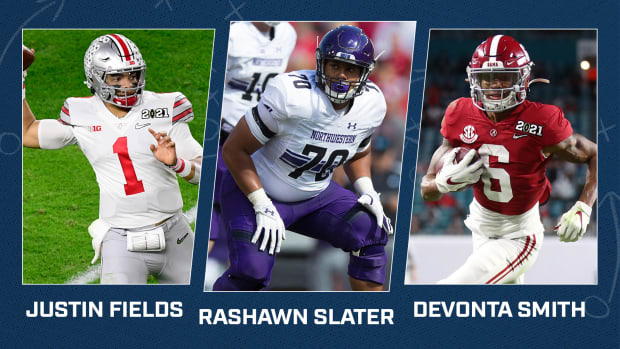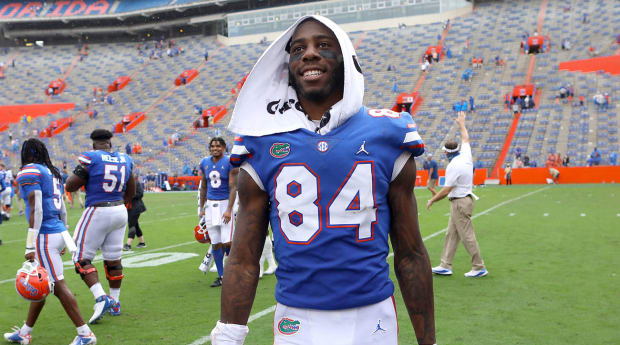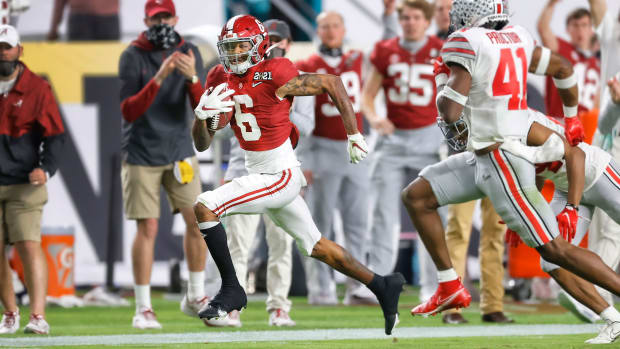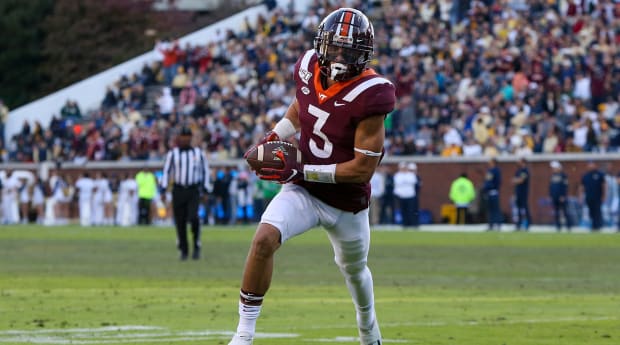Two of the five top QB prospects slide to the end of the top 10, as several teams fill other needs with offensive linemen and playmakers.
Trevor Lawrence has been penciled in as the No. 1 pick in this draft for two years, and I consider it refreshing that he and the Jaguars haven’t found it necessary to send faux smoke screens to stoke false intrigue. But there is plenty of real intrigue about the rest of the QB class after Lawrence and Zach Wilson: Whom did Kyle Shanahan trade up for? Will the Patriots make a move for a QB and who will it be? Will five QBs be drafted in the top 10, which didn’t even happen in the Great Quarterback Boom of 1983? This year’s draft class also includes a novel factor in evaluations, either in evaluating film from an atypical 2020 college football season or in assessing players who opted out last year as a result of the COVID-19 pandemic. But as Bill Belichick told reporters last week, “It’s maybe a little bit less information than we normally have, but all teams are working with the same general information.” That characterization is a bit too on the nose for us hapless mock drafters—in any year. Here’s this year’s try.

1. Jacksonville Jaguars: Trevor Lawrence, QB, Clemson
Two years ago, Albert Breer and I conducted a poll of NFL decision-makers at the spring league meetings, asking: Could any college football player go one-and-done into the NFL? This was the spring of 2019, right after Lawrence’s true freshman year at Clemson. “If he came out, he’d be the first pick in the draft this year,” one successful GM said of Lawrence. His arrival in the NFL has been long-awaited, which is why the Jaguars haven’t even tried to keep up the charade.
• Get the May 2021 issue featuring our Trevor Lawrence cover story here.
2. New York Jets: Zach Wilson, QB, BYU
It’s no secret the Jets are going QB at No. 2 after they traded Sam Darnold to the Panthers. It would be a heck of a smoke screen, with not much point, if that pick is not BYU’s Wilson. He has an incredible arm and an ability to make difficult throws on the move, though he’ll face a steep adjustment to the NFL from the competition level he faced in his breakout 2020 season. The Jets are ready to reset the clock with another rookie QB, but to succeed they’ll have to avoid the roster-building pitfalls and revolving coaching door that stunted Darnold’s development.
3. San Francisco 49ers (from Texans via Dolphins): Justin Fields, QB, Ohio State
The last time QBs went 1-2-3 in the NFL draft was in 1999, with Tim Couch to the Browns, Donovan McNabb to the Eagles and Akili Smith to the Bengals. The 49ers’ trade up to No. 3 assured this will again happen this draft—but what’s less clear is which QB they’ll choose. Shanahan likes to keep things close to the vest, so there have not been a lot of legitimate tea leaves to read. But you only make that big of a jump if you are going after a truly special player, and the 22-year-old Fields in Shanahan’s bootleg/play-action scheme is a tantalizing pairing.
4. Atlanta Falcons: Penei Sewell, OT, Oregon
I mucked up the MMQB Podcast’s mock draft extravaganza by assigning the Falcons a non-QB, and I’m here to do it again. The draft really begins this year at No. 4, and the Falcons could go in myriad directions. Matt Ryan’s contract restructure to give the team cap relief doesn’t preclude Atlanta from taking a QB, but the massive dead-cap charges the team would accrue by cutting or trading him in 2021 or ’22 makes it very likely Ryan will be the team’s QB the next two seasons. With that in mind, I’m giving the Falcons the best offensive lineman in this year’s class, someone who will immediately improve the run game, off which everything else in Arthur Smith’s offense depends. If the Falcons are not going to take a QB in the first round, they’d likely look to trade down—but that depends on finding a partner willing to come up this high for the fourth QB left on the board.
5. Cincinnati Bengals: Rashawn Slater, OT, Northwestern
There is no greater priority for the Bengals than to fix their offensive line. A receiver like Joe Burrow’s former college teammate Ja'Marr Chase might be tempting, but as Burrow returns from his season-ending left knee injury, which included a torn ACL, the most critical factor for his future success is strong offensive line play. We’re giving them the best tackle on the board at their pick, which in this exercise is Slater, who would make a strong bookend pairing with left tackle Jonah Williams, the team’s 2019 first-round pick.

6. Miami Dolphins (via Eagles): Kyle Pitts, TE, Florida
In the same year Belichick spent close to $90 million in free agency on a pair of tight ends, Pitts stands to be drafted uncommonly high for his position. The last tight end to be drafted sixth was Vernon Davis in 2006—and it’s possible Pitts will go even higher than this slot. After moving down to No. 12, Miami came back up to No. 6 for a playmaker for second-year QB Tua Tagovailoa. Pitts is a versatile offensive weapon made for today’s NFL, capable of lining up in-line, in the slot or split out as an X receiver. In just eight games last season for the Gators, Pitts pulled down 12 TDs—amounting to one score every four catches. Pitts would pair with Mike Gesicki for a formidable two-tight end set, like those favored by Brian Flores’s former team in Foxboro.
7. Detroit Lions: Ja'Marr Chase, WR, LSU
Maybe Jared Goff isn’t the answer in Detroit, but in order to give him—or any QB the Lions start—a chance, they need a true No. 1 receiver. This year’s draft class is deep at the receiver position, but similar to last year, there’s a trio that stands above the others (Chase, Jaylen Waddle and DeVonta Smith). The Lions, who let Kenny Golladay leave in free agency, are in good position to get one of these three.
8. New England Patriots (via projected trade with the Panthers): Trey Lance, QB, North Dakota State
That “It’s happening!” GIF would be the universal reaction if Belichick traded into the top 10 for a QB after never drafting one higher than pick No. 62 (a stat that sounds more significant than it is, given that Tom Brady was his starter for 19 of Belichick’s seasons as a head coach). But this has been an offseason unlike any other for the Patriots. Weeks after Brady won a Super Bowl elsewhere, they went on a free-agency spending spree, in part to make up for their accrued draft misses. Now, could they be so bold to move up for a QB? It’s never wise to read too much into something Belichick says to the media, but in his predraft press conference he brought up the idea of moving up for a player, saying, “Maybe at 12, 13, he’s still on the board and you really thought that he’d be gone in the top six, seven picks. Then the question comes, do you move up and try to get that player that’s fallen a little bit?” In this scenario we have New England moving up a bit further than that, leapfrogging the QB-needy Broncos to snag Lance, an intriguing prospect who would have time to develop behind Cam Newton.
9. Denver Broncos: Mac Jones, QB, Alabama
The Broncos have a new GM, George Paton, who will have a chance to do what John Elway could not: Find the next great young Broncos QB after Elway. They haven’t sought an upgrade to their 2019 second-round pick, Drew Lock, yet this offseason, so draft day will be the truth serum for their plans with him. It’s certainly within reason that they could trade up to No. 4—as esteemed Weak-Side Podcast co-host Conor Orr drew up in his mock draft last week—if there’s an available QB they love. But Paton has also talked about continuing the philosophy from Minnesota of acquiring as many draft picks as possible to have more chances of getting good players. Here we have them standing pat at No. 9 and being able to take the fifth QB, who in this exercise is Jones, thought by many evaluators to be a lower-ceiling/higher-floor prospect.
10. Dallas Cowboys: Patrick Surtain II, CB, Alabama
The Cowboys were thrilled last year that receiver CeeDee Lamb was still available for them at pick No. 17. They’d be just as thrilled if here they could snag Surtain, seen as the draft’s best CB, who would be an ideal fit for new DC Dan Quinn’s defense and has the potential to be a long-term fix for Dallas’s most glaring deficiency.
11. New York Giants: Jaylen Waddle, WR, Alabama
The Giants already added Golladay in free agency, but if a player like Waddle is available, they would be hard-pressed to pass up another weapon, to see whether Daniel Jones can make a leap forward in year three. You may have heard once or twice that Joe Judge worked under Nick Saban at Alabama, a connection they trusted in drafting Xavier McKinney last year, and which will help them assess both Waddle and his college teammate Smith in this year’s draft.

12. Philadelphia Eagles (from 49ers via Dolphins): DeVonta Smith, WR, Alabama
Big decision here for the Eagles: receiver or cornerback? When they traded down from No. 6 to 12, they made clear they were not taking a QB this year, but knew they’d still be in good position to take one of the top players at their positions of need. If five QBs do in fact go in the top 10, it’s possible the Eagles could get a steal with one of the two Alabama receivers. This would make two straight years for Philly taking a receiver in the first round, but the need is so acute, especially if they want to give Jalen Hurts a fair shake this season.
13. Los Angeles Chargers: Christian Darrisaw, OT, Virginia Tech
The Chargers fortified the interior of their offensive line in free agency, signing former Packers center Corey Linsley and ex-Steelers guard Matt Feiler, but new head coach Brandon Staley has acknowledged “the hole” they still have at left tackle. They can’t let their promising young QB Justin Herbert enter the 2021 season without that hole addressed. Darrisaw was a three-year starter at left tackle for Virginia Tech who, according to Pro Football Focus, allowed zero sacks and just six hurries in 293 pass-blocking snaps last season.
14. Minnesota Vikings: Kwity Paye, edge, Michigan
The Vikings could also go offensive line here, but a player like Paye could help them get back to having a defense that opponents fear. The Vikings were at their best under Mike Zimmer when they had a dominant defensive front, bookended by Everson Griffen and Danielle Hunter. Pairing Paye, a powerful and explosive pass rusher, opposite Hunter, would be a key step toward recreating that.
15. Carolina Panthers (via projected trade with the Patriots): Micah Parsons, LB, Penn State
Carolina’s trade for Sam Darnold doesn’t preclude them from taking a QB, but in this scenario, we have them instead taking advantage of the top-10 QB run to move back and pick up extra draft capital. The Panthers had an all-defense draft in 2020, but Parsons, a converted edge rusher who has the potential to fill the middle of Carolina’s defense in the way that Luke Kuechly once did, would be hard to pass up if he were available here.
16. Arizona Cardinals: Jaycee Horn, CB, South Carolina
With Patrick Peterson having left for Minnesota, and the Cardinals preferring to keep Byron Murphy in the slot, drafting an outside corner makes a lot of sense. Virginia Tech CB Caleb Farley’s March back surgery could be a factor in his going later than once expected. The speedy and physical Horn has the traits necessary to be a No. 1 corner in the NFL.
17. Las Vegas Raiders: Alijah Vera-Tucker, OL, USC
The Raiders have a lot of work to do on defense as well, but their offseason teardown of their offensive line has made it an acute need. After Las Vegas traded away tackle Trent Brown, guard Gabe Jackson and center Rodney Hudson, the versatile Vera-Tucker, who can play multiple positions in the trenches, would be an excellent asset.
18. Miami Dolphins: Azeez Ojulari, edge, Georgia
This year’s edge-rusher class is an unusual one, lacking top-five talent and with each of the top players at the position having something that gives evaluators pause. But that also means that in the middle of the first round, the Dolphins may have their pick of this year’s best. I like Ojulari here; he was very productive at Georgia, with 15 sacks in 23 games, and he would fit well as a 3–4 linebacker in Flores’s defense.
19. Washington Football Team: Jeremiah Owusu-Koramoah, LB, Notre Dame
Owusu-Koramoah played all over Notre Dame’s defense, lining up at linebacker, safety and even slot corner, displaying the versatility that is coveted in today’s NFL linebackers. He’d fill the void in Ron Rivera’s defense left by the departure of Kevin Pierre-Louis.
20. Chicago Bears: Greg Newsome II, CB, Northwestern
The Bears’ roster has many needs, none larger than QB, but their draft slot, plus the expected early run on the top-five passers, make them ill-positioned to take one in the first round. Newsome, who has generated a lot of predraft buzz, would help Chicago’s defense replace Kyle Fuller.
21. Indianapolis Colts: Teven Jenkins, OT, Oklahoma State
Anthony Castonzo’s retirement has left a hole for the Colts at left tackle. I struggled with the fit a little bit here as Jenkins played most of his college starts at right tackle, where Indianapolis is set with Braden Smith. But Jenkins also has experience at left tackle and right guard, allowing the Colts to play some offensive line combinatorics. And according to PFF, he did not allow a sack in his last two seasons at Oklahoma State.

22. Tennessee Titans: Caleb Farley, CB, Virginia Tech
The Titans, who have a cornerback need after cutting both Malcolm Butler and Adoree’ Jackson, could potentially get great value here if Farley is still on the board. He told NBC Sports’ Peter King he got good feedback post-microdiscectomy at the combine medical recheck, saying, “The NFL doctors confirmed I would be ready for the season, and they told me this is definitely not a chronic thing.”
23. New York Jets (via Seahawks): Gregory Rousseau, edge, Miami
Nearly as futile as the Jets’ quest for a QB has been their pursuit of a pass rusher. This could be the year that GM Joe Douglas gets his try at both in the first round. As we noted above, this is a difficult edge class to figure out. Rousseau last played in 2019, choosing to opt out of last season to help his parents, who were both frontline workers during the COVID-19 pandemic. In the ’19 season, he was behind only Chase Young with 15.5 sacks.
24. Pittsburgh Steelers: Najee Harris, RB, Alabama
Steelers owner Art Rooney II made clear in his season-ending press conference that reestablishing the ground game, after the Steelers ranked last in the league in rushing last season, will be a priority. Drafting Harris would give the Steelers a chance to feature the run game in a way they haven’t been able to since Le’Veon Bell left. Adding to the offensive line in the draft is another important part of doing so, but a deep draft class there will allow Pittsburgh to address the trenches in a later round.
25. Jacksonville Jaguars (via Rams): Trevon Moehrig, S, TCU
At this spot, Moehrig would be the best player available for the rebuilding Jaguars. He’d also complement the free-agency upgrades Jacksonville made to the secondary, in signing CB Shaquill Griffin and S Rayshawn Jenkins. Moehrig’s versatility and instincts for the ball could allow Jags defensive coordinator Joe Cullen to eventually use him as a movable piece who sows confusion for opponents, ideally similar to the way Pittsburgh has used Minkah Fitzpatrick.
26. Cleveland Browns: Jaelan Phillips, edge, Miami
The Jadeveon Clowney signing makes the Browns’ edge need a bit less urgent, but that may also give them the flexibility to take a gamble on one of the draft’s greatest risk/reward players. Phillips may be the most talented pass rusher in this year’s class, but he could slide because of his injury history, which includes serious wrist damage in a moped accident and multiple concussions at UCLA that led to his briefly retiring from football. He subsequently transferred to Miami and resumed his playing career with a standout 2020 season, in which he collected eight sacks and 15.5 TFL in 10 games.
27. Baltimore Ravens: Jayson Oweh, edge, Penn State
Trading back is always on the table for the Ravens—perhaps they can get a receiver they like a few slots later, while nabbing an extra pick. But if they stay here, edge rusher is a prime option, after losing both Matthew Judon and Yannick Ngakoue in free agency. Oweh’s lack of sacks in his final year at Penn State is not ideal, but PFF charted him as having 15 hurries and five QB hits in his seven games last season, showing that he was still affecting opposing QBs. He didn’t play organized football until his junior year of high school, and the Ravens’ coaching staff can help him refine his technique to harness his raw talent.
28. New Orleans Saints: Asante Samuel Jr., CB, Florida State
The Saints’ salary-cap constraints mean they’ll look to the draft to address needs, and foremost on that list is cornerback. Janoris Jenkins left in free agency, so they need a starter opposite Marshon Lattimore. Samuel is undersize but uses his agility and anticipation to make plays on the ball, to the tune of 29 PBUs in his college career.
29. Green Bay Packers: Jamin Davis, LB, Kentucky
The team that the Packers lost to in the NFC championship game offered a reminder of what they have long been missing: playmaking off-ball linebackers in the middle of their defense. The speedy and rangy Davis has the potential to be that player for the Packers. As for Aaron Rodgers’s preferences, this year’s receiver class is deep enough to justify the team’s pattern of addressing that position in the second or third round.
30. Buffalo Bills: Joe Tryon, edge, Washington
This is always an interesting part of the first round, where teams that fell just short of reaching the Super Bowl look for the piece or two that could get them over the hump. The Bills didn’t win the J.J. Watt sweepstakes, but they may look to address their middling pass rush with their top pick. Tryon, who is built like the prototypical pass rusher, has the potential to be a steal here; he was incredibly productive in 2019 (12.5 sacks) before opting out in ’20.
31. Kansas City Chiefs: Jalen Mayfield, OT, Michigan
This mock pick is brought to you by Not Overthinking It. The Chiefs rebuilt the interior of their offensive line in free agency, signing left guard Joe Thuney, center Austin Blythe and right guard Kyle Long. They still have a need at tackle, after releasing starters Eric Fisher and Mitchell Schwartz. Mayfield was a starter at right tackle for the Wolverines but also got some snaps as a fill-in left tackle as a freshman.
32. Tampa Bay Buccaneers: Christian Barmore, DT, Alabama
The Bucs have the rare luxury of returning all 22 starters from their Super Bowl LV team. The last to re-sign was Ndamukong Suh, on a one-year deal. Barmore is a quick and physical defensive tackle who primarily lined up as a 3-technique at Alabama. He could begin in a rotational role with the Bucs, as an interior pass rusher, with the potential to be pegged as Suh’s replacement.
More NFL Draft Coverage:
* Breer: 20 Things to Know About the Draft
* Rosenberg: The Unrivaled Arrival of Trevor Lawrence
* Orr: Rashod Bateman Says 2020 Made Him a Man
* Prewitt: What Happens to the Prospects Who Opted Out?